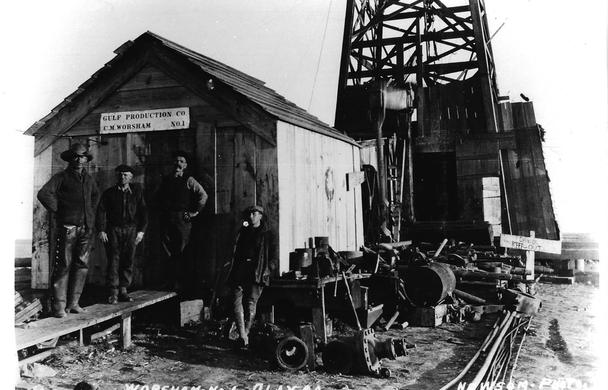In 1901, James William Lochridge owned a farm southeast of the current location of Petrolia, Texas. About this time there was a drought and remembering that his home place in Georgia had water wells, decided to drill one here. Enlisting the help of a local man with a drilling machine, he drilled down to 150 feet. The driller explained they had hit a dry hole, but he insisted on continuing. At about 156 feet, on August 15, 1901, they struck oil. Since the world was just coming into the machine age, there was no ready market for it. It was good only for killing mites on chickens and greasing wagon wheels.
The story goes that while he was in Henrietta, and explaining what had happened, several un-scrupulous bankers hearing the story and realizing the potential, took him to a saloon, and after several hours of drinking persuaded him to sign over most of his mineral rights for virtually nothing.
This was the discovery well, and the first in the Permian Basin area that included North Texas and Southern Oklahoma.
Shortly thereafter, The Texas Company, represented by W.B. Corlett, descended on the area and bought up all the mineral rights, usually at about 50 cents an acre.
Drillers and Roustabouts set up a shanty town they named Oil City in the area, and during it’s heyday the population reached an estimated 1200.
Soon thereafter, the Wichita Falls & Oklahoma Railroad laid a track through the area and across land platted by the Byers Brothers, and named Petrolia after an oil producing town in Pennsylvania. Most of the people planning a more permanent life here, moved closer to the railroad and the current site of Petrolia.
The oil at this level, 100 to 500 feet, was soon depleted and the industry declined. But in 1906 gas was discovered, and developed in 1907. The Lone Star Gas Company was created, and by 1909 lines were laid into Wichita Falls, making it the first city in Texas with municipal gas service.
In 1910, deeper drilling was started and the industry revived due to major discoveries. The company was the J.M. Guffey Petroleum Company of Beaumont, which later became the Gulf Oil Corporation. Their first deep well was the Dorothulia Dunn No.1, located about 3 miles east of Petrolia, in the general area where Lochridge originally hit oil. This well turned out to be a freak, with numerous dry holes around it. Disgusted, the company pulled out of the area, only to find other drilling companies hitting pay sands on virtually all sides of their property. This was the start of the great discoveries in the Permian Basin in areas such as Burkburnett, Iowa Park, South Wichita and Electra.
Three other companies, The Wilder-Underwood Drilling Company, The Ramey Oil Company and the Texas Company began drilling again. The primary objective prior to 1910 had been to locate gas. This time they went deeper to 1800 feet looking for oil deposits. Major discoveries were made.
The Texas Company still holds most of the oil rights, and Lone Star Gas still holds most of the gas rights in this area.
Shortly after the discovery of the gas producing areas of this field, probably about October 1907, it was determined that this gas contained approximately .1% helium, at that time the largest source for helium producing gas known. A small plant was constructed at Petrolia. Even though the gas had been depleted, the Navy in 1909 entered into a contract with the company operating the Petrolia field, to take 10 million cubic feet of gas, and send it through a government owned pipeline to Ft. Worth for the extraction of the helium. By 1925 it was evident that the field was entering the final stages of depletion and the cost of extraction was becoming prohibitive. After some searching, Potter County, Texas was selected as a favorable location and the plant in Ft. Worth was moved to a site seven miles west of Amarillo and was in production by May 1929.


Recent Comments